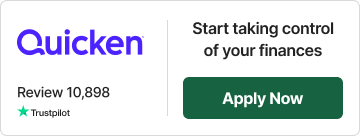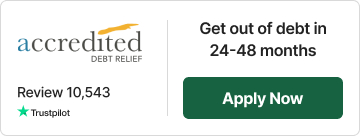Key takeaways
- Everyone can be debt-free. Start by creating a detailed budget, diligently tracking expenses, and finding out ways to cut back all without taking on more debt.
- Adopt effective debt repayment strategies like the snowball or avalanche methods, to systematically reduce and eventually eliminate debt.
- Debt relief is always an option. Look into debt consolidation, debt settlement, or even bankruptcy as a last resort.
No one wants to be in debt, but it’s a situation many people find themselves in.
Americans on average owe $5,875 in credit card debt and 40% have been in credit card debt for more than 5 years. It’s time to get out!
Even if you have a low income and have been trapped for years, there are effective steps you can take to manage your debt and break free. Let’s go over how you can turn your debt-free dream into a reality.
1. Stop Taking on New Debt
The first and most crucial step in managing debt is to stop accruing new debt. This involves a disciplined approach to your finances, including avoiding the use of your credit card, not opening new credit accounts, and resisting the temptation to take out loans for non-essential items.
This step can be challenging, especially if your income is only just covering your monthly expenses. However, it is a necessary measure to begin improving your financial situation. By halting the accumulation of new debt, you can start focusing on paying down your existing obligations and eventually achieving financial stability. Implementing a strict budget and prioritizing essential expenses over discretionary spending will aid in this process.
2. Create a Budget
Begin by listing all your sources of income so you have a clear understanding of exactly how much you make in a month. This includes your primary job, any secondary employment, freelance work, investments, and other sources of income. Next, determine your essential expenses, categorizing them into recurring expenses such as rent or mortgage payments, utilities, and groceries, and variable expenses like medical bills, transportation, and other necessary costs that might fluctuate monthly.
Once you have these numbers, subtract your total expenses from your total income. The remaining balance is the amount available for paying off your debt. It’s crucial to ensure this process is as accurate and thorough as possible to avoid any surprises.
Creating a budget is essential as it serves as your financial roadmap. It allows you to allocate funds appropriately, ensuring that essential expenses are covered while also dedicating a portion of your income towards reducing debt. By adhering to this budget, you can systematically work towards paying off your debt, ultimately achieving greater financial stability and freedom.
3. Know How Much You Owe
Now you’re ready to tackle your debt but you need a clear understanding of how much you owe.
Gather all your financial statements, including credit card bills, loan statements, and any other documents related to your debts. Create a comprehensive list of all your debts, noting the creditor, total amount owed, interest rates, monthly minimum payments, late fees, and any other penalties. This detailed overview will give you a clear picture of your financial situation. It helps you understand the scope of your debt and the best strategy to use to get out of debt.
4. Earn Extra Money
There are plenty of ways these days to increase your income, thanks to the expansive opportunities provided by the gig economy. You can explore options such as dog walking, ride-sharing, food delivery, and freelance work, which offer flexibility and the chance to earn extra money on your own schedule. Platforms like Uber, Lyft, DoorDash, and Rover have made it easier than ever to find gig work that fits your lifestyle and skills.
Alternatively, consider selling unused items around your home. This can be a quick way to generate cash, and platforms like eBay, Craigslist, and Facebook Marketplace make it easy to reach potential buyers. Becoming a tasker on Task Rabbit is another viable option; you can get paid for completing various tasks, such as home repairs, cleaning, or assembling furniture.
If you prefer a more traditional approach, look for part-time jobs that align with your skills and availability. Many retailers, restaurants, and businesses hire part-time workers, especially during busy seasons.
Regardless of the method you choose, increasing your income is crucial in managing and reducing your debt. Make sure to put all the extra money you earn towards paying off your debt. This proactive approach will help you achieve financial stability more quickly and reduce the burden of interest payments. By combining increased income with disciplined spending, you can create a solid strategy for becoming debt-free.
5. Cut Your Spending
Look for ways to reduce your expenses! There are numerous strategies you can employ to cut costs and free up more money to pay down your debt. Start by evaluating your discretionary spending and identifying areas where you can make cuts. For instance, consider cutting cable or switching to a more affordable streaming service. You can also reduce utility bills by being more energy-efficient, such as turning off lights when not in use, unplugging electronics, and lowering your thermostat.
Switching phone plans to a less expensive option or a family plan can also save money. Cooking at home instead of eating out is another effective way to reduce expenses; it’s often healthier and significantly cheaper. If you have a gym membership, think about canceling it and exploring free or low-cost exercise alternatives, like running, hiking, or at-home workout routines.
The possibilities for reducing expenses are endless and can be tailored to your lifestyle and needs. Every dollar saved is a dollar that can be redirected towards reducing your debt, accelerating your journey to financial freedom and stability.
6. Try the Snowball or Avalanche Methods
The two tried-and-true strategies to get you out of debt are the snowball method and the avalanche method. The snowball method involves focusing on paying off your smallest debts first while continuing to make minimum payments on your other debts. By eliminating smaller debts quickly, you can celebrate small milestones along the way, which can provide instant motivation and a sense of accomplishment to keep you moving forward. This method is particularly effective for those who need frequent boosts of encouragement to stay committed to their debt repayment journey.
The avalanche method, on the other hand, concentrates on paying off debts with the highest interest rates first. By targeting these high-interest debts, you minimize the amount of interest you pay over time, ultimately saving more money. This method requires discipline and patience, as it may take longer to see the first debt completely paid off, but the long-term financial benefits can be significant.
Both methods have their merits, and the best choice depends on your personal situation and financial behavior. If you thrive on quick wins and need consistent motivation, the snowball method might be the best fit. However, if you’re more focused on maximizing savings and can stay disciplined without immediate rewards, the avalanche method could be more suitable. Whichever method you choose, the key is to remain committed and consistent in your debt repayment efforts.
7. Negotiate with Creditors
If high interest rates are making it impossible for you to keep up with your debt payments, consider reaching out to your creditors to negotiate better terms. This can involve requesting lower interest rates, extended payment periods, or even a reduction in the total amount owed. Many creditors are willing to negotiate, especially if they believe it will increase their chances of getting repaid and if you have a history of making timely payments.
When approaching your creditors, it’s important to be polite, respectful, and honest about your financial situation. Explain your circumstances clearly and provide any relevant information that demonstrates your commitment to repaying your debt. It may be helpful to have a proposed payment plan ready to show that you are serious about resolving your debt.
Creditors prefer negotiating to recover some amount rather than risking the possibility of not being paid at all. By showing that you are proactive and responsible, you increase your chances of securing more favorable terms. This can provide much-needed relief and make your debt more manageable, allowing you to focus on paying it off without the overwhelming burden of high interest rates. Negotiating better terms can be a significant step towards achieving financial stability and regaining control over your finances.
8. Explore Debt Relief
If your debt situation is particularly dire and no matter what you do it doesn’t seem to make a difference, consider exploring debt relief options. These options include debt consolidation, credit counseling, debt settlement, or even bankruptcy as a last resort. Each of these strategies has its own set of benefits and considerations, so it’s essential to research and understand the implications before proceeding.
Debt consolidation involves combining multiple debts into a single loan with a lower interest rate, making payments more manageable. Credit counseling provides guidance and education on managing finances and creating a budget, often accompanied by a structured repayment plan. Debt settlement entails negotiating with creditors to reduce the total amount owed, potentially providing significant relief if successful.
Bankruptcy, while a last resort, can offer a fresh start by discharging certain debts. However, it has long-term consequences on your credit score and financial future. Debt relief companies can assist by negotiating with creditors on your behalf to secure better terms or decrease the amount you owe. It’s crucial to choose a reputable company and understand any fees or potential impacts on your credit.
Exploring debt relief can be a critical step towards regaining financial stability when traditional methods fail. Carefully evaluate your options, seek professional advice if necessary, and take informed steps to resolve your debt situation effectively.
Final Thoughts
Debt can feel like a trap, especially if you have a low income and not much money to spare. However, it’s important to remember that getting out of debt is possible, even in challenging circumstances. By following a strategic approach, you can make progress and gradually eliminate your bills one by one.
Start by stopping the accumulation of new debt and creating a clear picture of your financial situation. List all sources of income and essential expenses to determine how much you can allocate towards debt repayment each month. Employ methods like the snowball or avalanche strategy to systematically pay off your debts. Look for ways to cut expenses, such as reducing utility bills, cooking at home, and using coupons. Increasing your income through gig work, selling unused items, or taking on a part-time job can also accelerate your debt repayment.
If necessary, reach out to creditors to negotiate better terms, or consider debt relief options like debt consolidation, credit counseling, or even bankruptcy as a last resort. Remember, it may take time and patience, but the freedom from debt is worth the effort. By staying committed to your plan and making consistent progress, you can achieve financial stability and break free from the burdens of debt.


